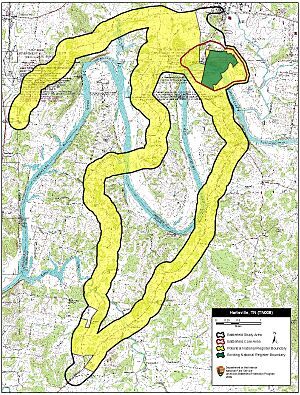Battle of Hartsville facts for kids
Quick facts for kids Battle of Hartsville |
|||||||
|---|---|---|---|---|---|---|---|
| Part of the American Civil War | |||||||
|
|||||||
| Belligerents | |||||||
| Commanders and leaders | |||||||
| Absalom B. Moore (POW) | John Hunt Morgan | ||||||
| Units involved | |||||||
| XIV Corps | |||||||
| Strength | |||||||
| 2,400 | 1,300 | ||||||
| Casualties and losses | |||||||
| 2,096 |
139 |
||||||
|
Hartsville Battlefield
|
|||||||
| Lua error in Module:Location_map at line 420: attempt to index field 'wikibase' (a nil value). | |||||||
| Nearest city | Hartsville, Tennessee | ||||||
| Area | 245 acres (99 ha) | ||||||
| MPS | Tennessee Resources of the American Civil War MPS | ||||||
| NRHP reference No. | 98001247 | ||||||
| Added to NRHP | October 28, 1998 | ||||||
The Battle of Hartsville was a fight during the American Civil War. It happened on December 7, 1862, in northern Tennessee. This battle was part of the larger Stones River Campaign. Today, the Hartsville Battlefield is a special historical site. It is listed on the National Register of Historic Places.
Why the Battle Happened
The Stones River Campaign began in November 1862. Union General William Rosecrans led his army from Nashville, Tennessee, towards Murfreesboro. Confederate General Braxton Bragg had moved his army to Murfreesboro. This was after he lost a battle at Perryville.
General Bragg told Colonel John Hunt Morgan to take his cavalry north. Their job was to stop Rosecrans's army from getting supplies. They also wanted to cut off his communication lines. The fighting at Hartsville was part of Morgan's plan. Hartsville was an important place to cross the Cumberland River. It was about 40 miles from Nashville.
The Battle Begins
Union soldiers were guarding the river crossing at Hartsville. This group was the 39th Brigade. It included soldiers from Ohio, Illinois, and Indiana. Colonel Absalom B. Moore was their commander.
In the early morning of December 7, 1862, Morgan's men crossed the river. They did this under the cover of darkness. Morgan had about 1,300 soldiers, mostly from Kentucky. The Union brigade had about 2,400 troops. So, the Union soldiers outnumbered Morgan's men. Another Union force was nearby, but too far to help.
Morgan's attack surprised the Union camp. Some stories say the Confederates wore blue uniforms. Others say they dressed as regular people. The attack started at 6:45 a.m. with cannons firing and soldiers attacking. Cavalry soldiers attacked from the sides and behind.
One Union group broke and ran after an hour. This caused confusion among the Union soldiers. They were forced to retreat. By 8:30 a.m., the Confederates had surrounded the Union soldiers. Colonel Moore decided to surrender.
What Happened Next
A Union regiment, the 75th Indiana, was camped nearby. They heard the cannons and marched towards Hartsville. They moved slowly, as they might have met Morgan's cavalry.
When they reached the battlefield, they found wounded soldiers. Both Union and Confederate soldiers were left in the snow. Morgan's men had already won the battle. Some of Morgan's soldiers were barefoot and needed clothes. They took Union shoes and supplies. They filled several wagons with what they found. About 200 soldiers were killed or wounded in total.
Basil W. Duke, a Confederate leader, wrote about the battle. He said 15 Confederate soldiers were "frozen so stiff" and left behind. Union wounded were also left. The 2,004 Union prisoners were marched south to Lebanon.
Duke also wrote that the Confederates knew the Union's strength. They knew where the Union soldiers were placed. Morgan made sure to have scouts and soldiers ready. Their job was to stop any Union chase. The Confederates moved quickly. Some Union prisoners had to walk through the Cumberland River.
Morgan's victory was a big success. He lost 139 men. But he captured 1,844 Union prisoners. He also took many wagons full of supplies. General Joseph E. Johnston was a top Confederate commander. He called Morgan's win a "brilliant feat." He suggested Morgan become a brigadier general right away. Jefferson Davis, the Confederate president, was in Murfreesboro. He promoted Morgan in person.
The Battle of Hartsville showed what Confederate cavalry could do. Similar raids happened later. These were led by Nathan Bedford Forrest and Morgan himself. General Rosecrans arrived in Murfreesboro on December 29. This set the stage for the Battle of Stones River.


